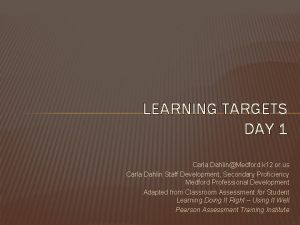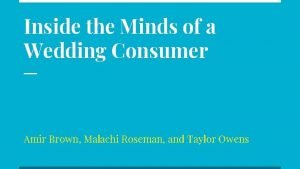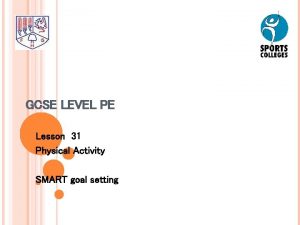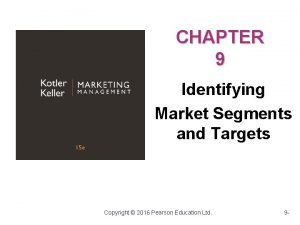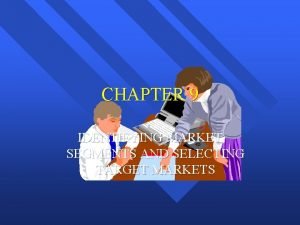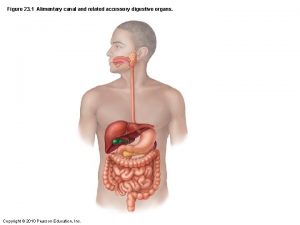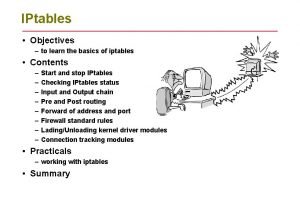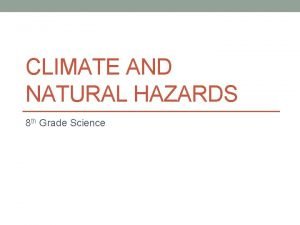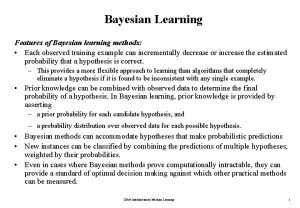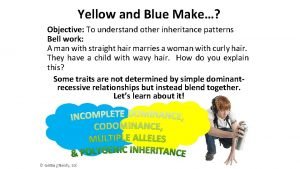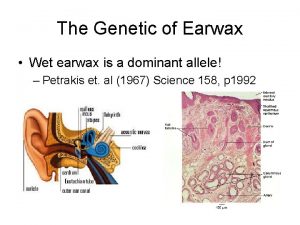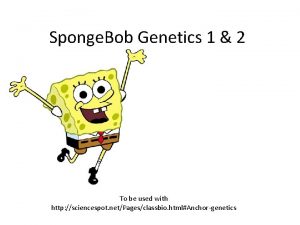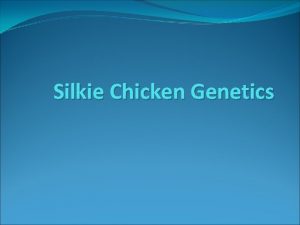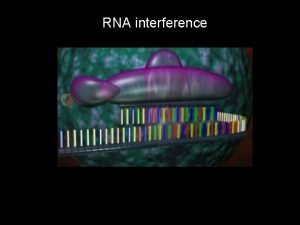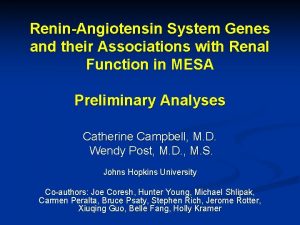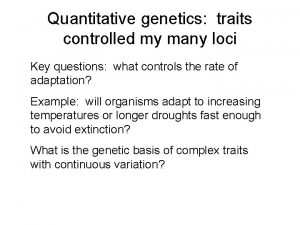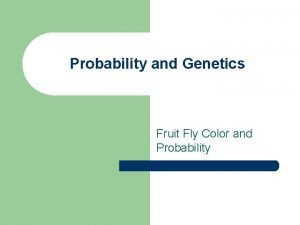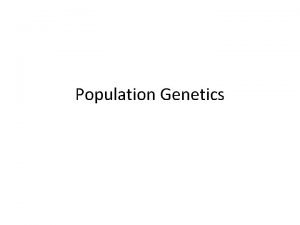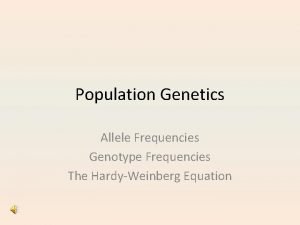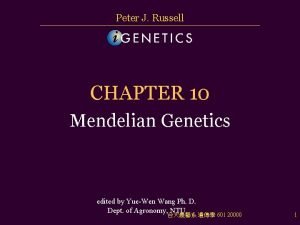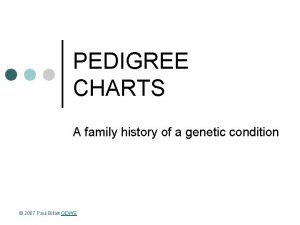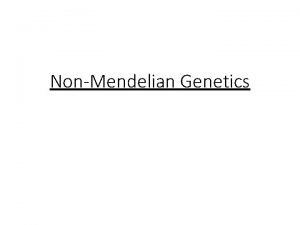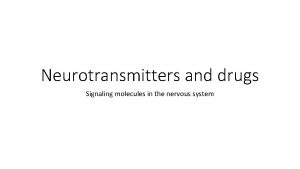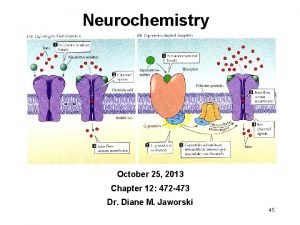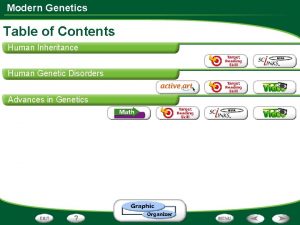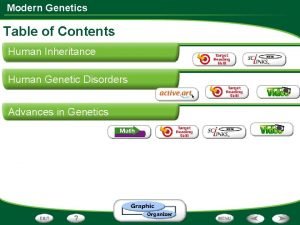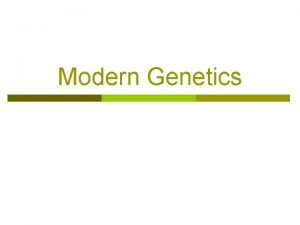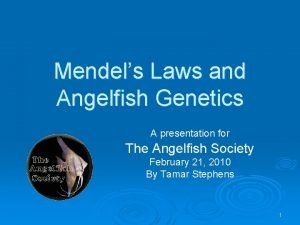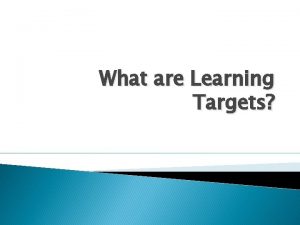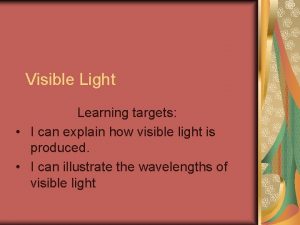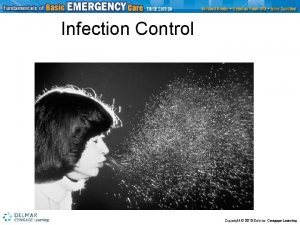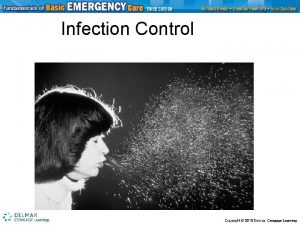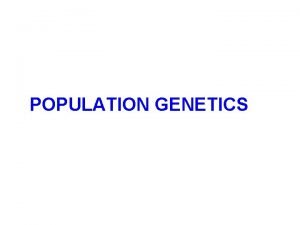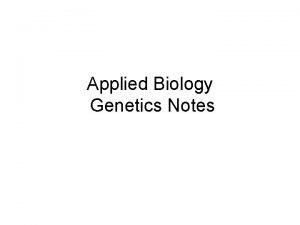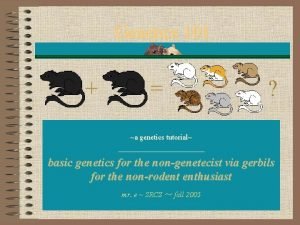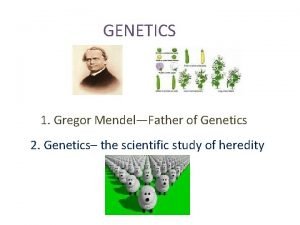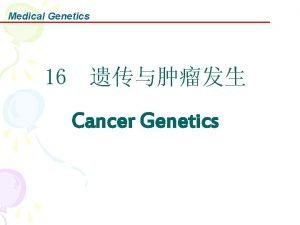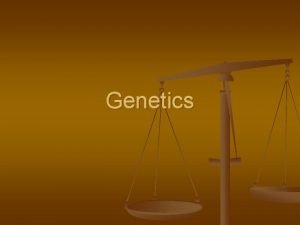Genetics 11 1 Learning Targets I can explain



























































- Slides: 59

Genetics 11. 1

Learning Targets �I can explain how genes pass traits from parents to offspring � I can describe the role of chromosomes in heredity � I can identify patterns of heredity in humans � I define genetics, dominant gene, recessive gene, genotype, and phenotype

Genetics Experiments Human Heredity Twins Mendel Applied Genetics Genetic Diseases Morgan Environment Selective Breeding Genetic Engineering

Genetics and Heredity � Genetics � What is the study of heredity is heredity? › The passing on of traits from parents to offspring › All organisms pass information (DNA) about traits to their offspring

Mendel � More than 100 years ago, a scientist named Gregor Mendel made important discoveries about heredity � He took seeds from tall pea plants and planted them. � Some plants were tall, but some were short. WHY? ?

Mendel’s Studies � Mendel decided to study pea plants and their seeds � He wanted to grow only tall pea plants � Since the flowers of pea plants have both male and female sex organs, Mendel tried self-pollination � Self-pollination occurred when Mendel moved pollen from the male sex organs to the female sex organs on the same plant

Mendel’s Studies (cont. ) � After self-pollination occurred, each flower produced seeds � Mendel planted the seeds and then selfpollinated the plants that grew from those seeds � He did this again and again � Finally, Mendel had seeds that produced only tall pea plants (pure tall seeds)

The “P” Generation � Using the same self-pollination process, Mendel grew only short plants as well (pure short seeds) � Mendel �P called these plants the P Generation. stands for the parent generation

Cross-Pollination � Eventually, Mendel wanted to know what type of offspring two different pure parent plants would make � He used the process cross-pollination to find out. � Cross pollination is the movement of pollen from the male sex organs to the female sex organs of a different plant

The F 1 Generation � So Mendel moved the pollen from pure tall pea plants to the female sex organs of pure short pea plants (and vice versa) � When the seeds produced plants, Mendel took the seeds from those flowers and planted them. � He called these plants the F 1 Generation � F stands for filial (son or daughter)

Results of F 1 Plants � Mendel found that all F 1 Generation plants were tall � He crossed hundreds of pure short plants with pure tall plants � All the results were similar…tall plants � What happened to the short trait? ?

Punnett Squares Short pure P generation T T t Tt Tt (tall) Tall pure P generation F 1 Generation All tall

Punnett Squares � Mendel used these to explain his crosses �A gene is the information that a parent passes to its offspring for a trait �A pea plant inherits two genes for height (one gene received from each parent)

Genes �A gene that is hidden when it is combined with another gene is called a recessive gene (lower case letter) � The gene that shows up is called the dominant gene (capital letter) � All pea plants were tall, so the dominant gene is tallness

Genotypes and Phenotypes � An organism’s combination of genes for a trait is called its genotype � For example, the genotype of the F 1 pea plants is Tt � What an organism looks like as a result of its genes is its phenotype � The phenotype of the F 1 pea plants was tall

The F 2 Generation � Mendel then self-pollinated the F 1 Generation plants � Mendel found that short plants started showing up again (25% of the time) � This F 2 Generation always included short plants � Short plants reappeared because in the F 2 Generation, the plants inherited two recessive genes for shortness

Punnett Square T T t TT Tt (tall) F 2 Generation F 1 Generation (Tt) t F 1 Generation (Tt) Tt tt (tall) (short) ¾ Tall ¼ Short

Mendel’s Conclusions � Mendel concluded that there was information in a plant that caused it to have certain traits � The dominant genes hid the appearance of recessive genes � The offspring receive half their genes from one parent and half from the other

Vocabulary � Genetics � Self-pollination � Cross-pollination � Dominant � Self Gene Genotype Phenotype Gene Recessive Gene Check questions, pg. 238 #1 -5 � COMPLETE SENTENCES

What are Chromosomes? 11. 2

What are Chromosomes? � Rod-shaped structures made of proteins and a chemical called DNA � Found �A in the nucleus of the cell chromosome can contain hundreds of genes, which determine all the traits of an organism

Mitosis Review � Basic › › steps to Mitosis: Chromosomes make a copy of themselves Nuclear membrane dissolves The two sets of chromosomes separate A nucleus forms around each set of chromosomes › RESULT: Two new identical cells each with a nucleus and set of chromosomes

Mitosis and Cell Division � Following mitosis, the entire cell divides � Each new cell gets one nucleus with a complete set of chromosomes � Each set of chromosomes is identical to the parent’s (new cell is identical to parent cell)

Sexual Reproduction � Two gametes (sex cells) join to form one complete cell � Each gamete has only half of the chromosomes of other cells in the body � When gametes join, they form a cell that has a complete set of chromosomes

How Many Chromosomes? � Most human have 46 chromosomes in their body cells � Sperm cells and egg cells only have 23 chromosomes each � Sperm and egg join to form a cell called a zygote with 46 chromosomes total � Together, the 46 human chromosomes carry 50, 000 -100, 000 genes

Meiosis Review � Basic › › steps to Meiosis: Chromosomes make a copy of themselves The cell divides into two new cells Each new cell then divides again RESULT: One parent cell results in four new sex cells › **Each sex cell contains half the number of chromosomes of the parent cell

Sex Chromosomes � Humans have 46 chromosomes; they consist of 23 pairs � Each chromosome that makes up a pair comes from a different parent � For 22 of the pairs, the two chromosomes look alike � However, the chromosomes that make up the 23 rd pair look different from each other these are sex chromosomes

Sex Chromosomes (cont. ) � These two chromosomes determine a person’s sex � There are two types of sex chromosomes › X and Y › Females have two X chromosomes › Males have one X and one Y chromosomes

How are sex chromosomes passed? � Parents pass one of their sex chromosomes on to their offspring �A male can pass an X or a Y chromosome to its offspring �A female can only pass an X chromosome to its offspring

Human offspring � Human offspring have a 50% chance of being male or female Male Parent X Y X X XX XX (female) XY XY (male) Female parent Offspring 50% chance of being female (XX) 50% chance of being male (XY)

Thomas Morgan � Morgan used fruit flies rather than pea plants to learn about chromosomes and genes � Fruit flies are easy to study because: › › Their cells have only 4 pairs of chromosomes The chromosomes are large; easy to see Fruit flies reproduce quickly It’s easy to tell the female fly from the male

Sex-Linked Traits � Traits that are linked to the sex of an organism are called sex-linked traits � Fruit flies usually have red eyes � Morgan noticed one male fly with white eyes � He mated the white-eyed male with a red-eyed female

Results � This resulted in the F 1 Generation and all flies had red eyes (dominant trait) � Morgan found that when he mated flies from his F 1 Generation to produce an F 2 Generation, some flies had white eyes and some had red � However, all white-eyed flies were male

Results (cont. ) � Morgan concluded that the white eye color in fruit flies is linked to the sex of the fly �A female fruit fly has two X chromosomes �A male has one X and one Y chromosome

� Morgan found that the gene for eye color in fruit flies is on the X chromosome � There is no gene for eye color on the Y chromosome � This explains why eye color in fruit flies is a sex-linked trait

Vocabulary � Sex Chromosome � Sex-linked Trait � Carrier � Self-Check questions, pg. 245 � COMPLETE SENTETCES!!

How is Heredity studied in Humans? 11. 3

Human Genetics � Human genetics is the study of how humans inherit traits � Humans have more chromosomes, do not reproduce quickly, and cannot be used in experiments � Scientists study heredity in humans by studying identical twins

Different kinds of Twins � Identical Twins › Sperm and egg join, form one zygote › Zygote divides into two cells that separate › Cells have identical genes � Fraternal Twins › Form from two different zygotes › Zygotes develop into offspring with different sets of genes

Heredity and Environment � Your genes determine your skin color, eye color, body shape, and other characteristics � But your environment can also affect your characteristics � Scientists study identical twins who have been separated since birth � Both twins have identical genes, but grew up in different environments

The Influence of Environment � Food, sunlight, air and other parts of the environment can affect characteristics �A person who doesn’t have good nutrition may not grow tall, even though they have the gene for tallness � X-rays and some types of chemicals cause changes in genes, called mutations

DNA � DNA in chromosomes is the material that contains an organism’s genes � DNA passes the genes from one cell to another during cell division � DNA is a large molecule shaped like a twisted ladder � The rungs of the ladder are made of four different kinds of molecules called bases

Bases � The order of the bases in the DNA of a cell provides a code for all the information that the cell needs to live � Different organisms have different orders of bases � The greater the difference between organisms, the greater the difference in order of bases � The four bases are abbreviated as: › T, A, C, and G

Difference of Bases � The order of bases in a frog’s DNA is very different from the order of bases in human DNA � But, the difference in the order of bases between your DNA and your friend’s DNA is not as great � The order of bases in a gene for hair color, for example, determines whether the hair will be black, red, brown, or blonde

DNA Replication � DNA can replicate, or copy, itself � DNA molecules are held together at the rungs of the ladder � The bases pair up in certain ways � When DNA replicates, it first splits down the middle of its rungs � The paired bases separate, then new bases pair with the separated bases

� The result is two identical copies of the original DNA molecule � DNA replication occurs every time a cell divides normally � Pairing of Bases: › Base A pairs with Base T › Base C pairs with Base G

Mutations � Sometimes there is a change in the order of bases in a DNA molecule � Parts of the environment and chemicals can cause mutations � Mutations cause changes in genes � Genes determine traits, so any mutation can affect the traits of an organism

Genetic Diseases � Mutations can be harmful, helpful, or have no effect to the organism � A genetic disease is a disease that results from the genes a person inherits � Recessive genes cause most genetic diseases � That means a person must inherit the recessive gene from both parents in order to have the disease

Inbreeding �A gene pool is all the genes that are found within the population � The larger the population, the larger the gene pool � People living in a small population, often mate others who may have the same or similar genes � Sexual reproduction among people in a small gene pool is called inbreeding

Diseases � Inbreeding can cause a disease called hemophilia � This disease causes the blood to not have a certain protein that it needs to clot or clump � People who have hemophilia bleed excessively when slightly injured � Hemophilia was known as the “Royal Disease” WHY? ?

Human Sex-linked Traits �A number of human traits are sex-linked � The gene for color blindness in sex-linked � Color blindness is more common in males because the recessive gene is found on the X chromosome � Hemophilia and muscular dystrophy are also sex-linked � Both are found on the X chromosome, so they are both more common in males

Vocabulary � Mutation � Base � Genetic Disease � Self-Check Replicate Gene Pool Inbreeding Questions, pg. 251 � COMPLETE SENTENCES!!

What is Applied Genetics? 11. 4

Applied Genetics � Farmers use breeding techniques to grow hardier and better-tasting crops � Animal breeders use breeding techniques to make prizewinning horses � These are examples of people affecting the traits that organisms inherit

Useful Mutations �A mutation that results in an animal with white fur would be helpful to that animal in a snowy region � Over long periods of time, mutations may lead to changes in population � This is one way that new species are formed

Selective Breeding � Farmers and scientists use their knowledge of genetics to produce new varieties of plants and animals � Selective breeding is selecting useful mutations and breeding organisms so the mutation shows up again � Examples: Short legged sheep, cows that produce large amounts of milk, pink grapefruits and navel oranges

Breeding Racehorses � Selective breeding is used to produce great race horses � The breeder will select two parents with desirable genes � The will also select parents that have good temperaments � An animal’s genes also affect its behavior

Genetic Engineering � The process of introducing new genes into an organism is genetic engineering � Began in the 1970’s when scientists transferred genes from one species of bacteria to another species of bacteria � Today, scientists transfer genes between entirely different organisms � Used to treat certain diseases or conditions of plants and animals

Vocabulary � Applied Genetics � Selective Breeding � Genetic Engineering � Self-Check questions, pg. 256 � COMPLETE SENTENCES!!
 Writing learning targets
Writing learning targets Learning targets
Learning targets Final sketch
Final sketch Knowledge targets examples
Knowledge targets examples Learning targets knowledge, reasoning, skill product
Learning targets knowledge, reasoning, skill product Learning targets helping students aim for understanding
Learning targets helping students aim for understanding Cuadro comparativo entre e-learning b-learning y m-learning
Cuadro comparativo entre e-learning b-learning y m-learning Objectives of warehouse
Objectives of warehouse Jim crow laws in what region or regions did it exist
Jim crow laws in what region or regions did it exist Brides magazine targets consumers who are in
Brides magazine targets consumers who are in Targets of change
Targets of change Smart target gcse pe
Smart target gcse pe Identifying market segments and targets chapter 9
Identifying market segments and targets chapter 9 Identifying market segments and targets chapter 9
Identifying market segments and targets chapter 9 Identifying market segments and targets chapter 9
Identifying market segments and targets chapter 9 Nyseslat levels
Nyseslat levels The nfl targets several different market segments
The nfl targets several different market segments Early childhood education barbados
Early childhood education barbados Identifying market segments and targets
Identifying market segments and targets Physical targets
Physical targets Multiattack multiple targets
Multiattack multiple targets Identifying market segments and targets
Identifying market segments and targets Pituitary hormones and their targets
Pituitary hormones and their targets Peristalsis and segmentation
Peristalsis and segmentation Europe 2020 targets
Europe 2020 targets Europe 2020 targets
Europe 2020 targets Alohahsap
Alohahsap On training targets for supervised speech separation
On training targets for supervised speech separation Iptables command
Iptables command Single segment concentration
Single segment concentration A tiny groove in soil made by flowing water
A tiny groove in soil made by flowing water Explain how a sound can be ‘sampled’
Explain how a sound can be ‘sampled’ How can class evidence narrow a field of suspects
How can class evidence narrow a field of suspects Explain three ways in which
Explain three ways in which Bill nye weather and climate worksheet
Bill nye weather and climate worksheet What are the objectives of selection
What are the objectives of selection Explain brute force bayes concept learning
Explain brute force bayes concept learning Explain the factors affecting learning
Explain the factors affecting learning Genetics yellow and blue make answer key
Genetics yellow and blue make answer key Earwax type genetics
Earwax type genetics Sponge billy bob
Sponge billy bob Silkie colors
Silkie colors Section 1 meiosis
Section 1 meiosis Forward genetics
Forward genetics Genetics model
Genetics model Quantitative genetics
Quantitative genetics Probability in genetics
Probability in genetics Learn.genetics.utah/content/addiction/mouse
Learn.genetics.utah/content/addiction/mouse Population genetics
Population genetics What is gene frequency in genetics
What is gene frequency in genetics Branch diagram dihybrid cross
Branch diagram dihybrid cross Allele key
Allele key Dominant
Dominant Http://learn.genetics.utah.edu/content/addiction/
Http://learn.genetics.utah.edu/content/addiction/ Adrenaline in the brain
Adrenaline in the brain Blood type codominance practice problems answers
Blood type codominance practice problems answers Human inheritance modern genetics answer key
Human inheritance modern genetics answer key Genetics graphic organizer
Genetics graphic organizer Modern genetics human inheritance answer key
Modern genetics human inheritance answer key Angelfish genetics
Angelfish genetics



